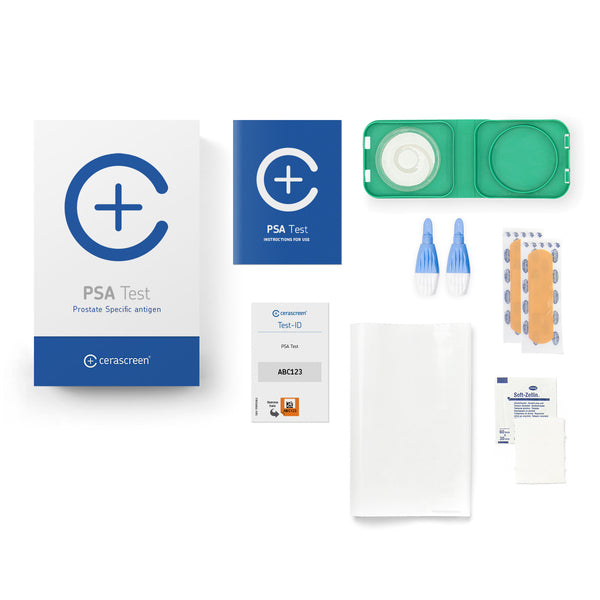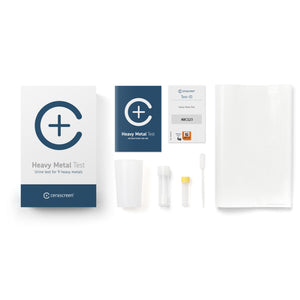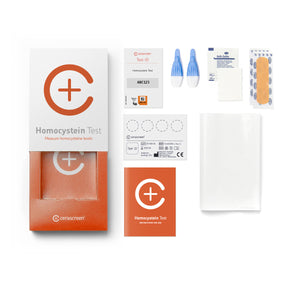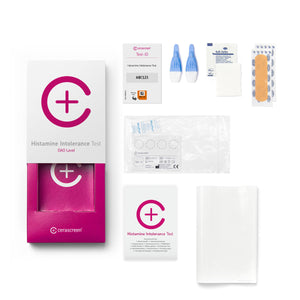product_id = 6656493584443variant_id = template_name =

PSA Test
About the test
The cerascreen® PSA Test measures the concentration of prostate-specific antigen (PSA) in a blood sample. If you have detected a potentially increased risk of poor prostate health, you can have a targeted medical examination at an early stage – in many cases, this increases the chance of being able to treat disease well.
High PSA levels can be an indication of various prostate diseases, including prostatitis (inflammation of the prostate), benign prostate enlargement and prostate cancer.
PSA Test
- Take your sample at home – conveniently and discreetly
- Receive a state-of-the-art laboratory analysis
- Receive recommendations on how to prevent prostate diseases
- Receive your result within 5 to 7 working days after sample’s arrival in the laboratory
Prostate prevention at home with the PSA test

Prevention at home:
For the test, you take a few drops of blood yourself - conveniently and discreetly at home, without the need for a doctor's appointment just for a blood sample.

Well-founded laboratory value:
The sample is analyzed in a medical laboratory, with which doctors' offices and clinics also cooperate. You can discuss the result of the PSA test with your doctors and plan further steps.
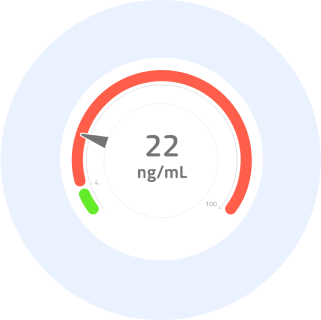
Early diagnosis:
The PSA value provides indications of diseases of the prostate, including prostatitis (inflammation of the prostate), benign prostate enlargement and prostate cancer.

Detecting Invisible Risks:
Prostate diseases often do not manifest themselves through symptoms for years. The PSA value is a common warning to detect and treat diseases early.
Benefits of the PSA Test
Changes in the prostate gland are usually not noticeable through distinct symptoms. That’s why tests are very valuable: PSA levels can be used to detect and treat diseases at an early stage.
Take your sample for the cerascreen® PSA Test at home – without hours of doctor’s visits or waiting times! The test is a blood test, for which you only need a small finger prick of blood. The blood sample is then analysed in our specialist medical laboratory.
Benefit from our expertise: cerascreen® is the market leader for medical sampling and send-in kits in Europe, with eight years of experience in test development and analysis. We have developed more than 50 approved send-in test kits (medical devices), analysed 250,000 samples and serve 19 countries in Europe – and now the United States!

Result of the PSA Test
As soon as your sample has been analysed, you will receive your results report of your PSA levels via the My cerascreen® app or your user account on our website. You can easily view the report on your smartphone, tablet or computer and print it out, if required.
Our laboratory analysis will tell you the concentration of prostate-specific antigen in your blood. With the help of our recommendations for action, you can find out when it makes sense to visit your doctor and how you can prevent prostate diseases. The comprehensive health information we provide explains various risk factors for prostate cancer and the symptoms of different prostate diseases.
Frequently asked questions about PSA Test
Why take the PSA blood test?
Whether it’s inflammation, benign enlargement or cancer, prostate diseases can be treated better the earlier they are detected.
For example, prostatitis (inflammation of the prostate) can become chronic if it is not treated early, with consequences spanning from problems with urination to erectile dysfunction. Prostate cancer can be fatal. In the United Kingdom, it is the most common type of cancer in men, with more than 48,000 new cases recorded every year.
At the same time, some changes in the prostate (such as prostate cancer) are often not accompanied by noticeable symptoms for a long time. The PSA Blood Test can help to get an early indication of such diseases, which can improve the chances of treatment.
It is important to get a medical examination if you have elevated PSA levels. This is because in many cases, PSA levels are elevated without cancer causing them. Doctors can look into this more closely and give you recommendations for treatment, depending on the diagnosis.
Who should take the PSA Test?
All men or people who have a prostate should consider taking the cerascreen® PSA Test.
As a rule, examinations for detecting prostate cancer are recommended for men from the age of 45, as the cancer usually occurs at an older age. However, other diseases of the prostate, such as prostatitis, can affect people of all ages.
A PSA Test is particularly useful if you suspect you have an increased risk of prostate cancer – for example, because there are cases of prostate cancer in your family.
How does the PSA Blood Test work?
For the PSA Blood Test, take a small blood sample from your fingertip with a lancet. Only a few drops of blood are needed for this. Collect the drops on a dry blood card – this way, you only have to take a very small amount of blood and the sample can be stored for a long time.
The sample is sent free of charge to our specialised medical laboratory in a return envelope. The laboratory analyses the concentration of prostate-specific antigen in your blood.
After the lab analysis, you will receive a notification telling you that you can access the results report by logging in to your account on our website or via the My cerascreen® app.
How long does the analysis take in the laboratory?
Once your sample has arrived at the laboratory, it will be analyzed there by specialists. How long the analysis takes depends on the exact measuring method and the processes in the laboratory.
If the sample is sent on the correct days (Sunday to Tuesday), this makes it easier for the laboratory to adhere to the times.
For the PSA Test, the laboratory analysis is usually completed within 7 working days after the sample is received in the laboratory.
What does the results report tell me?
The results report notifies you of your PSA levels and therefore the concentration of prostate-specific antigen (PSA) in your blood.
You will also find out whether your PSA levels are within the reference range – that is, within the usual range used as a reference for healthy adults. If the PSA value is above 4 nanogrammes per millilitre of blood, it is considered to be high, according to these reference values.
What recommendations will I receive?
If your PSA levels are in the higher range, we recommend that you contact your doctor for further tests.
We will also give you a number of recommendations to help you avoid risk factors for prostate cancer and prevent prostate disease. This primarily involves leading a healthy lifestyle with a balanced diet and regular exercise.
What is a PSA level?
The prostate-specific antigen (PSA) is a protein that is produced in the prostate by healthy cells. The larger the prostate, the more PSA is produced – which is why levels usually increase with age, when the prostate naturally enlarges.
But diseases can also cause the prostate to grow and release more PSA. This is the case with benign prostate enlargement, but also when cancer cells develop in prostate cancer.
The more PSA is produced in the prostate, the more can be detected in the blood – this is the basis of PSA blood tests.
What is prostatitis?
Prostatitis (inflammation of the prostate) is usually caused by a bacterial infection, in which pathogens migrate from the blood, bladder or urethra into the prostate.
Prostatitis can cause various unpleasant symptoms, especially:
- Pain in the perineal area
- Fever
- Difficulty and pain urinating
- Erectile dysfunction
- Fatigue and weakness
If the disease lasts three months or longer, experts call it chronic prostatitis. Symptoms are usually not as severe as with acute prostatitis.
What is benign prostate enlargement?
When non-malignant cells multiply in the prostate gland and cause it to grow, this is called benign prostatic syndrome (BPS) or benign prostatic enlargement. This change in the prostate is very common in older age.
These benign cell changes do not usually develop into prostate cancer. However, an enlarged prostate can cause symptoms such as frequent urination, pain when urinating and incontinence.
What is prostate cancer?
Prostate cancer is one of the most common cancers of all. Worldwide, it is the second most common cancer in men and the fifth leading cause of death.*
The most important risk factor for prostate cancer is age. This type of cancer is very rare in people under 50, but the risk rises sharply in older age. It is likely that very old men almost always develop prostate cancer – studies in which people were examined in a post-mortem after their death revealed that nine out of ten men over 90 had this tumour in their bodies.
It is true that some tumours in the prostate can grow quickly and lead to dangerous metastases. However, prostate cancer often grows slowly or not at all for a long time. As long as the cancer remains in the prostate, it usually causes little discomfort. Because the cancer often grows so slowly, the numbers of deaths from prostate cancer are also relatively low, even though the disease is so common. In fact, those affected by prostate cancer often die of other causes.
* Source: Rawla, Prashanth. ‘Epidemiology of Prostate Cancer.’ World journal of oncology, vol. 10.2 (2019), pp. 63-89, doi:10.14740/wjon1191.
How is prostate cancer diagnosed and treated?
To detect prostate cancer early, urology specialists perform PSA tests as well as palpation examinations on the prostate.
In the United Kingdom, a PSA test alone is not enough to diagnose someone with prostate cancer – although it can detect aggressive forms of the cancer or a slower-growing cancer. Most men are now offered an MRI, for example, to confirm or rule out prostate cancer.
If the PSA value, palpation, ultrasound or MRI reveal a reason to suspect prostate cancer, doctors usually perform a biopsy. This involves taking tissue from the prostate, which is then examined in the laboratory. This biopsy usually leads to a clear diagnosis.
If a tumour is found in the prostate, it can be treated with surgery, radiotherapy, chemotherapy or hormone therapy. If the cancer is in an early stage and has not yet metastasised, it is often easy to cure. However, surgery can lead to complications and side effects such as incontinence and impotence.
Why are children under 18 not allowed to take the test?
Our tests are not suitable for underage children and adolescents under the age of 18. Under 18s cannot activate the tests online and therefore cannot receive a test result. We ask that you do not administer the tests to your children either.
Children and adolescents need much closer supervision and counselling regarding medical tests and their interpretation. Testing with lancets and chemicals is not without risk and would need to be closely supervised by guardians. In addition, the reference values we give are always based on adult data. In the case of children, the risk of misinterpreting the results would be very high.
We want to fulfil our responsibility as a provider of medical products and ensure that children and adolescents are not unsettled by measurement results that are difficult for them to interpret. Since we cannot control whether the minors' legal guardians actually consent to the test being carried out and supervise them, we exclude tests for under 18s altogether.
If you are under 18 and have purchased a test, please contact our customer support.
Why does it take up to a week for the sample to reach the lab?
Please bear in mind that your results will not be analyzed in the UK but in Germany. For that reason, it can take up to a week for the sample to arrive at the lab. This does not affect the stability of the samples, as the method we are using is optimized for long transports.
Initially, your sample is sent to our collection center in the UK. From there, it is shipped to our central sample sorting facility in Germany, which then distributes samples to our partner laboratories. Once your sample is analyzed there, you will receive a notification and can access your result online.
Please check your mailbox regularly. We will notify you as soon as your sample is sent, arrives, or is analyzed.
This is how it works
1. Test at home
Your test kit contains everything you need to draw a small sample of blood from your fingertip. Then send the sample back to us free of charge in the enclosed return envelope.
2. View results online
After the evaluation in the medical specialist laboratory, you will have online access to your personal result report.
3. Act
Your access to the test results and the evidence-based findings and tips to improve your health: the my cerascreen® user profile on our website or our app.






